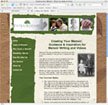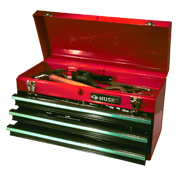
July 09, 2008
Welcome to Memoir Musings
Welcome to Memoir Musings, your newsletter from Extraordinary Lives. Our goal is to inform and inspire you to save your family stories.
If you enjoy the newsletter, please forward it to family and friends who might enjoy it too.
Enjoy your memoir journey!
Newsletter Contents
Feature: Disaster-If You Had Just Five Minutes...
Family Corner: Childhood Reality Show
What's New at ExtraordinaryLives.com
How-To Tip: Photo Organization and Backup
Disaster! If You Had Just Five Minutes...

At my family reunion last week, my cousin Ann shared pictures of the damage to her home from the recent rash of tornadoes across the plains. Her damage was minor (although still $25,000!); homes on either side and across the street sustained terrible damage. One picture from inside the neighborís house showed portions of someone elseís roof sitting in their dining room. Amazingly, a shelf holding antique china was still in place on the wall, as was the china! To borrow from our teensí dialect, thatís random!
Damage in other communities has not been random at all-itís been complete and devastating. Throughout the Midwest and plains, thousands of farms, homes and businesses are underwater. Tormadoes ravage places not yet recovered from Hurricane Katrina. Fires are bearing down on homes in California. Newscasts show people picking through piles of ashen, sodden or crushed rubble, looking for something, anything, worth salvaging. The loss of expensive furnishings, electronics, and even dwellings are shrugged off; they are replaceable. The most sought-after items are photos and family heirlooms.
Itís a solemn reminder to all of what matters most in life-loved ones and the memories that surround them are what we seek. Itís a painful but useful exercise to occasionally ponder what we would want to grab from our homes if we needed to leave in five minutes time.
Our family keeps an emergency bag in our foyer closet; it contains some clothing, flashlights, first aid supplies and personal records. It does not contain our photos, my Momís demitasse set or our daughtersí cherished childhood teddy bears.
Dishes and teddy bears, tucked away in trunks and cabinets, remain at risk in an emergency. However, we have taken steps to save copies of photos, stories and documents that are priceless to our family. Itís not a perfect system, but we take comfort in knowing that a good portion of our history is saved, even if our home was flattened or blown away.
Here are some options to consider:
- Photos: if you have a digital collection, subscribe to a backup or photo service that keeps a copy for you. Creative Memories, Mozy, iMac are all options to explore. If your photos are printed, save the negatives in a separate location such as a safety deposit box.
- Documents: scan and preserve digital copies offsite, using the above-mentioned services. Historically significant documents should be kept in safe deposit boxes or with a document storage service.
- Scrapbooks: Scan or take digital photos of your pages and store offsite. If the pages are too large to scan, scan them in parts and use Photoshop Elements to ďstitchĒ the scans together.
- Movies: it is relatively easy to copy VHS and DVDs of home movies. If you donít have the equipment, contact companies that can copy for you (we can help with that). Then, save a copy offsite.
- Memorabilia: This is the most difficult; you want it displayed to enjoy it, but display means itís at risk for damage. At the very least, take high quality pictures so that if the items were lost, at least you have something to preserve the memories. Supplementing the pictures with stories of the source and meaning of the items further protects the memories associated with the memorabilia.
The loss we are witnessing in our communities is painful beyond words. I hope the families find some measure of peace in their searches.
Family Corner: Childhood Reality Show

Does this happen to you? You are going about some daily routine with your children and you are suddenly transported back to your own childhood, to a similar moment in your memory. Families often do a fantastic job of saving memories about special events, preserving them with photos, movies, and stacks of cards. Yet the way we live our lives on the most ordinary of days is often far more revealing about our family, personalities and society in general.
Try this project: pick an ordinary summer day and create a ďday in the life ofĒ movie for each family member. If you have a video camera, use it to film sleeping, waking, eating, playing, chores and so on. You will have a meaningful and likely hilarious account of not only how each child spends their day, but also their attitudes and demeanor. And, you will have a picture of the clothes, friends, food, toys, tools and technologies of the day, which we know change at a frightening clip. As your children grow up, let them make this movie themselves; it will reveal yet another layer of your childís personality.
If you donít have a video camera, you can accomplish much of this with a still camera, or at least with a schedule/story written on paper or the computer.
If you did your reality show once per year, imagine the life record youíd have for your children as the years march on. Donít limit your cameras to the special events; the everyday world is endless fascinating when we look back at how things have changed!
What's New at ExtraordinaryLives.com?

Visit www.ExtraordinaryLives.com and check out our printable Photo Log form. It's a great way to supplement your photo storage system and helps you maintain story details.
Monthly Memory Prompt: Disasters

Many people I work with recall the great 1937 flood, when much of Covington, Newport and downtown Cincinnati were underwater, as were other cities along the Ohio river. The destruction was widespread, and disruption to daily life was severe. Families were often broken up, with children distributed among relatives in safer areas. The current rash of disasters illustrate how regularly such natural disasters occur and how they continue to disrupt life, despite far more sophisticated prevention and recovery methods.
Has your life been touched by one of these natural disasters-flood, tornado or severe storm, earthquake, hurricane or fire?
- Describe any warning systems in place or lack there of
- What preparations were taken in your home and community?
- What were the hours like prior to the disaster?
- Were you home during itís onslaught? What did it sound like? Look like?
- What did you fear the most?
- How were your other family members acting/coping?
- What items did you and others try to save or rescue?
- Were you driven from your home? How did you leave?
- What type of damage did your home and community sustain?
- Were people injured? Were there deaths in your community?
- What caused the most grief in your family?
- How did you and your family personally recover?
- Describe returning to your home for the first time.
- What did you lose that you missed terribly?
As you look back, how was your life altered by this event? Was it a major turning point or a minor setback in your life? In the midst of this hardship, do you recall any humorous moments or conversations? Such moments often come back and soften some of the harshness of the event.
How-To-Tip: Photo Organization and Backup

The best safeguard for your photo collection is to keep copies in two different physical locations. That could mean negatives in a safe deposit box, with printed photos at home, or backups of your digital photos at an internet-based storage site or on CD at a second location. That is the most critical step.
If you have precious framed photographs in your home, either take digital pictures of them or scan them, so copies can be kept elsewhere.
However, the act of saving photos is only part of the task; what about the details and meaning of those photos? Without words, they represent mysteries, either now or in the future. Here are some ways to add words:
- If you are saving negatives for film, include a description of the pictures, at the very least, the dates, locations and people. You can even purchase special sleeves for your negatives that are safe for long-term storage and have room to add such detail. Take a look at such products from archival material providers such as Light Impressions.
- If you care saving copies digitally, use keywords in your photo-storage software. This lets you add tags to your digital files with cursory details (name, event, year).
- Also use a photo log to add more detail than the tags are designed to do. (You will find a printable Photo Log form on our web site.) Filling out this form shortly after taking the photos gives you a great head start on memory book journaling or memoir writing. Store the form with the cd or dvd of your photos. If you are using backup software, make sure your photo logs are included in your backup list.
Whatever your methods, create a regular schedule of off-site storage, so that you minimize losses should disaster strike your home.
Thank you for subscribing to Memoir Musings.
Please email or call 513.385.1637 with any questions or suggestions. If someone forwarded this newsletter to you and you'd like to subscribe for future issues, click on the link below: